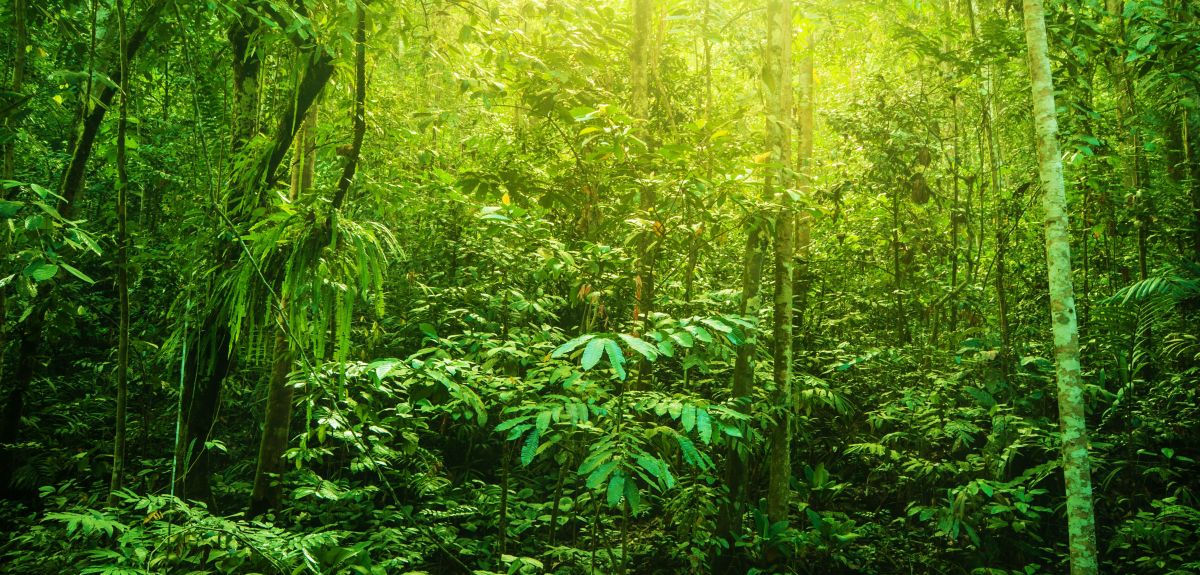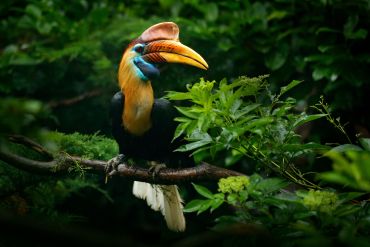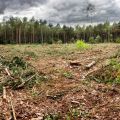
Replanting logged forests with diverse seedlings accelerates restoration, says Oxford study
One of the world’s biggest ecological experiments, co-led by the University of Oxford on the island of Borneo, has revealed that replanting logged tropical forests with diverse mixtures of seedlings can significantly accelerate their recovery. The findings, published today in the journal Science Advances, emphasise the importance of preserving biodiversity in pristine forests and restoring it in recovering logged forest.
The experiment was set up by the University of Oxford’s Professor Andy Hector and colleagues over 20 years ago, as part of the SE Asia Rainforest Research Partnership (SEARRP). This assessed the recovery of 125 different plots in an area of logged tropical forest that were sown with different combinations of tree species. The results revealed plots replanted with a mixture of 16 native tree species showed faster recovery of canopy area and total tree biomass, compared to plots replanted with four or just one species. However, even plots that had been replanted with one tree species, were recovering more quickly than those left to restore naturally.
 Professor Hector, the lead scientist of the study, said, ‘Our new study demonstrates that replanting logged tropical forests with diverse mixtures of native tree species achieves multiple wins, accelerating the restoration of tree cover, biodiversity, and important ecosystem services such as carbon sequestration.’
Professor Hector, the lead scientist of the study, said, ‘Our new study demonstrates that replanting logged tropical forests with diverse mixtures of native tree species achieves multiple wins, accelerating the restoration of tree cover, biodiversity, and important ecosystem services such as carbon sequestration.’
Greater diversity gives greater resilience
According to the researchers, a likely reason behind the result is that different tree species occupy different positions, or ‘niches’, within an ecosystem. This includes both the physical and environmental conditions to which the species is adapted, and how it interacts with other organisms. As a result, diverse mixtures complement each other to increase overall functioning and stability of the ecosystem. For instance, some tropical tree species are more tolerant of drought because they produce a greater amount of protective chemicals, giving the forest resilience to periodic times of low rainfall. Professor Hector added, ‘Having diversity in a tropical forest can be likened to an insurance effect, similar to having a financial strategy of diverse investment portfolios.’
‘This two-decade long experiment continues to promote interdisciplinary research and develop strong links between Sabah and the University of Oxford. Using new technologies and initiatives, we hope to continue to build on this valuable body of work, including through our new Leverhulme Centre for Nature Recovery.’
Professor Andy Hector, Department of Biology, University of Oxford.
In turn, a diverse mix of trees can support a much wider range of animal life. For instance, hornbills specifically require large mature trees with holes where the females can nest.
One of the world’s biggest ecological experiments
Tropical forests cover just 6% of the planet’s land surface but are home to around 80% of the world’s documented species (WWF), and act as major carbon sinks. However, these critical habitats are disappearing at an alarming rate, chiefly because of logging for timber and conversion to palm oil plantations. Between 2004 and 2017, 43 million hectares of tropical forest were lost - an area roughly the size of Morocco (WWF).
 Knobbed Hornbill. Shutterstock
Knobbed Hornbill. ShutterstockTo investigate, the researchers collaborated with local partners to set up the Sabah Biodiversity Experiment on 500 hectares of logged forest in the Malaysian state of Sabah on the island of Borneo. This was divided into 125 experimental plots. These were either left to recover naturally or planted with mixtures of either one, four or 16 tree species frequently targeted for logging. The 16 species included several endangered species and the worlds’ tallest species of tropical tree (Shorea faguetiana), which can reach over 100 m in height. The first trees were planted in 2002, with nearly 100,000 planted (in total) over the following years.
‘The Sabah Biodiversity Experiment bridges that gap between large-scale work relevant to forestry and highly controlled experimental design, in order to provide relevant research for policy makers in tropical forest systems.’
Ryan Veryard, Department of Biology, University of Oxford.
The recovery of the plots was assessed by applying statistical models to aerial images captured by satellites. Within a few years, it became apparent that those with one species did worse than those planted with a mixture of four species, and those enriched with 16 species did best of all.
 Lead author Ryan Veryard (who analysed the data as part of his Oxford doctoral studies), said, ‘Importantly, our results show, that logged forest can recover so long as it is not converted to agricultural uses, such as oil palm plantation. They also emphasise the need to conserve biodiversity within undisturbed forests, so we can restore it in areas that have already been logged.’
Lead author Ryan Veryard (who analysed the data as part of his Oxford doctoral studies), said, ‘Importantly, our results show, that logged forest can recover so long as it is not converted to agricultural uses, such as oil palm plantation. They also emphasise the need to conserve biodiversity within undisturbed forests, so we can restore it in areas that have already been logged.’
The Sabah Biodiversity Experiment team is now starting a new three-year project, funded by the UK Natural Environmental Research Council, to take a census of all the surviving trees in the experiment. This will be combined with a wider range of remote sensing methods (including lidar sensors carried by a helicopter and smaller sensors carried by drones) to give a more comprehensive analysis of forest health.
The study ‘Positive effects of tree diversity on tropical forest restoration in a field-scale experiment’ has been published in Science Advances.
 Dr Ashwin Jainarayanan selected for 2024 Schmidt Science Fellow program
Dr Ashwin Jainarayanan selected for 2024 Schmidt Science Fellow program
 New study to improve vaccines and therapeutics development
New study to improve vaccines and therapeutics development
 Nature degradation could cause a 12% loss to UK GDP
Nature degradation could cause a 12% loss to UK GDP
 Alok Sharma to join the Oxford Martin School as a Visiting Fellow
Alok Sharma to join the Oxford Martin School as a Visiting Fellow
 Landmark study definitively shows that conservation actions are effective at halting and reversing biodiversity loss
Landmark study definitively shows that conservation actions are effective at halting and reversing biodiversity loss